Coronavirus (COVID-19): public attitudes and behaviours - April update
Findings from polling work, conducted between September 2021 and January 2022, on public attitudes and behaviours around the coronavirus pandemic in Scotland.
This document is part of a collection
1. Wellbeing
Worry and optimism
This section covers how people have felt at different points in the pandemic, between September 2021 and January 2022, and thinking ahead. Respondents were asked:
- how they feel about the Coronavirus situation
- whether they believe things will get better soon
- how positive or negative they feel about life in the month and year ahead
- what their main concerns are in 2022
Worry
From September 2021 to January 2022, between 46% and 60% of respondents agreed that they have felt worried about the Coronavirus situation (Figure 1). More people reported feeling worried in the run up to Christmas, at 14-15 December 2021, where 3 in 5 (60%) agreed that they were worried. This was at the time when Omicron was spreading rapidly. By mid-January 2022, worry had reduced to 46%.
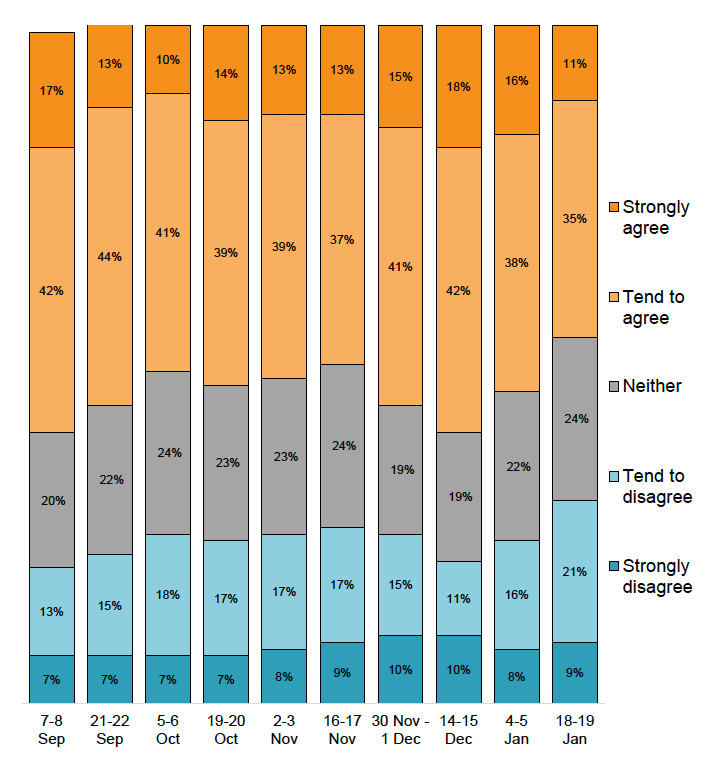
Source: YouGov Scotland Survey. Base: Adults (n=1001-1044)
Optimism
To get a sense of how optimistic people are feeling, survey respondents were asked whether they agreed or disagreed that things will start to get better soon. Between September 2021 to January 2022, responses varied (Figure 2), typically reflecting changes in the COVID-19 situation. Over this time period, between 24% and 49% agreed that things will start to get better soon, while between 20% to 44% disagreed with the statement. Consistent with worry about the Coronavirus situation in Figure 1, people were least optimistic in mid-December 2021 and most optimistic in mid-January 2022.
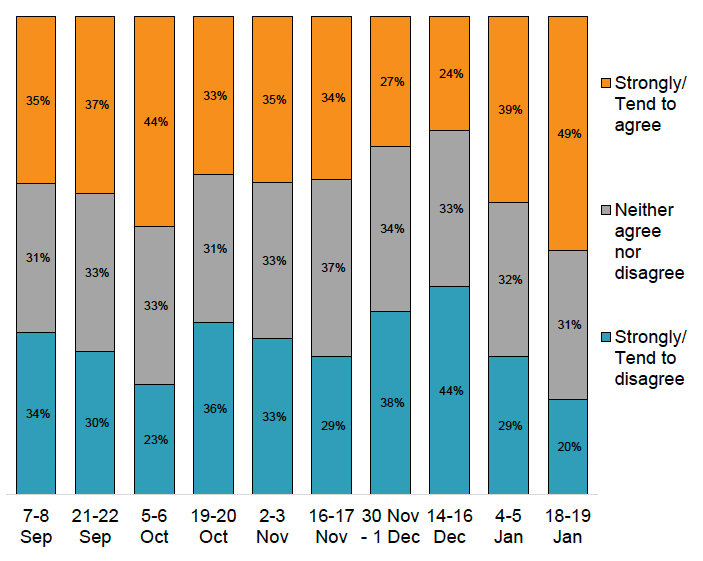
Source: YouGov Scotland Survey. Base: Adults (n=1001-1044)
At the beginning of January - a week after Scotland recorded the highest number of COVID-19 infections, according to positive PCRs (Public Health Scotland) - respondents were asked how positive or negative they felt about the following:
- children returning to school in January
- life during January (2022)
- life in the year ahead (2022)
The data shows a substantial proportion of respondents were worried about all of these things, but the largest worry was about January 2022.
Almost 2 in 5 respondents (37%) (Figure 3) felt positively about children returning to school in January, 1 in 5 (20%) felt negative, and the largest proportion (43%) felt neither positive or negative. When asked about life during the month of January, the responses were more evenly mixed: with around a third of respondents feeling positive (32%), around a third feeling negative (35%), and another third feeling neither positive or negative (33%). More respondents felt positive about the overall year ahead (2022), compared to the immediate month ahead in January. 45% of people reported feeling positive about life in the year ahead, and a quarter felt negatively (24%), with a third (31%) feeling neither.[3]
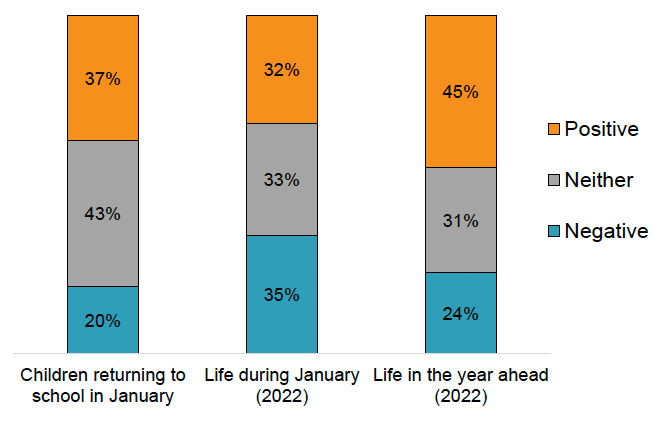
Source: YouGov Scotland Survey. Base: Adults (n=1012)
Biggest concerns
Respondents were given a list of options and asked to select their top three biggest concerns (ranked 1st, 2nd, and 3rd) when thinking about the year ahead. Figure 4 shows the top ranked concerns, with the percentages representing the proportion of respondents who placed each concern as one of their three biggest concerns.[4]
The ranking of respondents' main concerns were mostly the same at 19-20 October as when the question was repeated two months later, on 14-15 December. However, by December more respondents were concerned about delays/ backlog in NHS treatment/ operations of non-COVID related issues caused by Coronavirus. 46% of respondents placed this in their top 3 concerns in October, increasing to 53% in December. Concern about new strains emerging also increased by 6 percentage points (from 34% to 40%). Also, concerns about the longer term impacts of the coronavirus pandemic on jobs, businesses and the economy rose by 11 percentage points, and concern for the longer term impact on mental health rose by 9 percentage points.
Meanwhile, fewer people were concerned about energy prices by December (36%), compared to 47% in October. However, energy prices remains the third top concern. Concern about empty shelves in supermarkets also decreased from 28% in October to 16% in December.
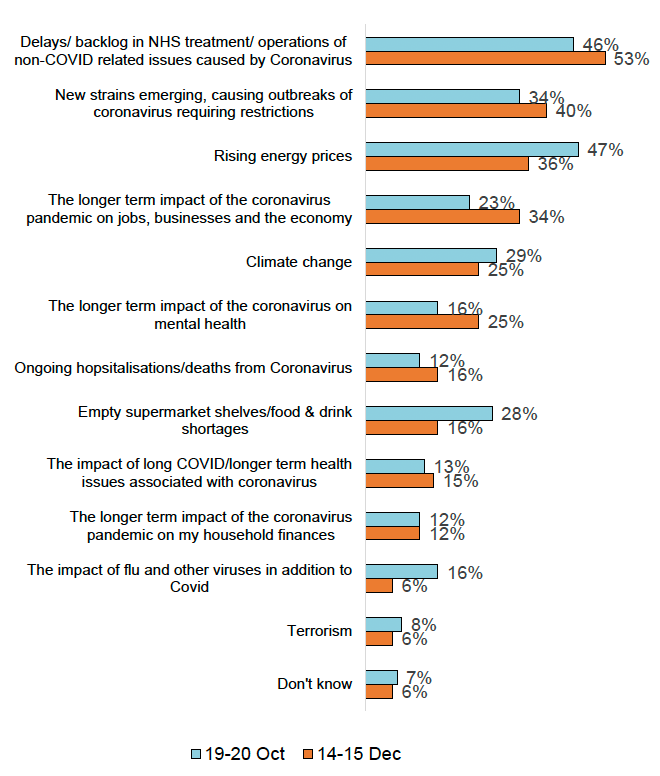
Source: YouGov Scotland Survey. Base: Adults (n=1003-1022)
Levels of loneliness, anxiety and happiness
The Coronavirus pandemic continues to have a wide range of impacts on personal wellbeing. This section presents data about the impacts of the pandemic on feelings such as loneliness, anxiety and happiness.
Loneliness
To understand social isolation, respondents were asked how much of the time during the past week they had felt lonely.
The survey found continued high levels of loneliness, with just under half of respondents (between 45% and 49%) reporting that they felt lonely at least some of the time over this period (see Figure 5). This was 49% in September, reducing to 45% at the beginning of October and then returning to 48%-49% at the start of December and January. These levels of loneliness are broadly similar to the level measured in January 2021.
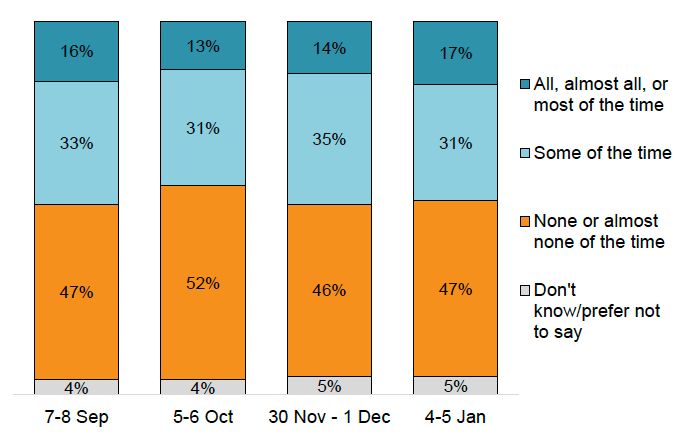
Source: YouGov Scotland Survey. Base: Adults (n=1001-1044)
The survey also included two of the Office for National Statistics' (ONS) wellbeing questions to measure levels of anxiety and happiness. Respondents were asked how anxious, and how happy, they felt 'yesterday', on a scale of 0 to 10.
Anxiety
At least one third of respondents (32% to 38%) consistently reported 'high' anxiety (score of 6-10), see Figure 6. The numbers of respondents with 'high' anxiety remain higher than pre-pandemic measures (23% of the population in Scotland), [6] but lower than the high levels (60%) reported at the beginning of the first national lockdown.[7]
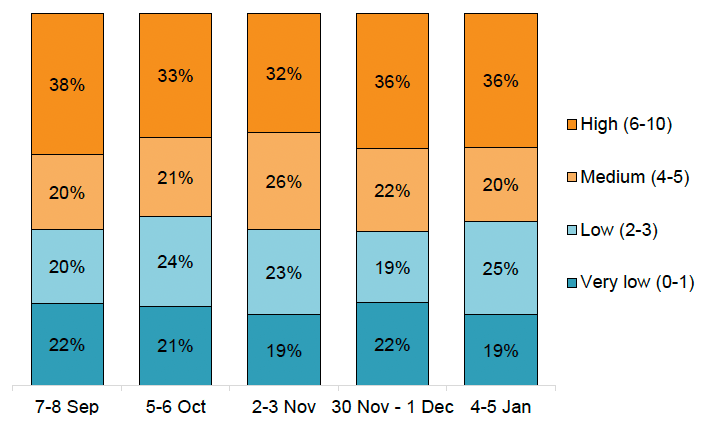
Source: YouGov Scotland Survey. Base: Adults (n=1001-1044)
Happiness
1 in 5 respondents or fewer (between 16% to 20%) reported 'low' happiness (score of 0-4).
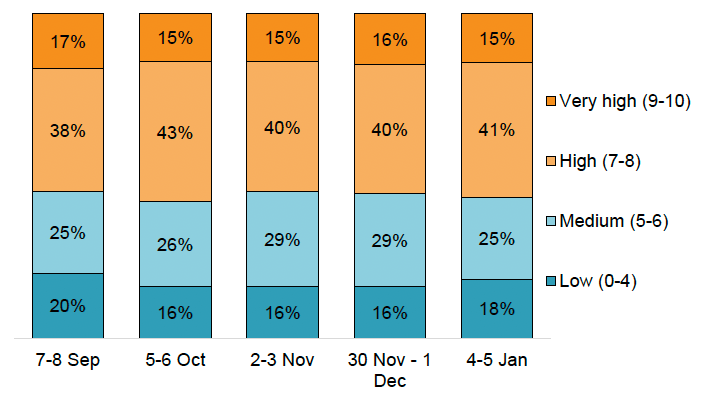
Source: YouGov Scotland survey. Base: Adults (n=1001-1044)
Mental health
Between October to January, worry about the effect of the ongoing pandemic on mental health incrementally increased: with 37% on 5-6 October, 39% at 30 November-1 December, and 43% by 4-5 January (Figure 8).
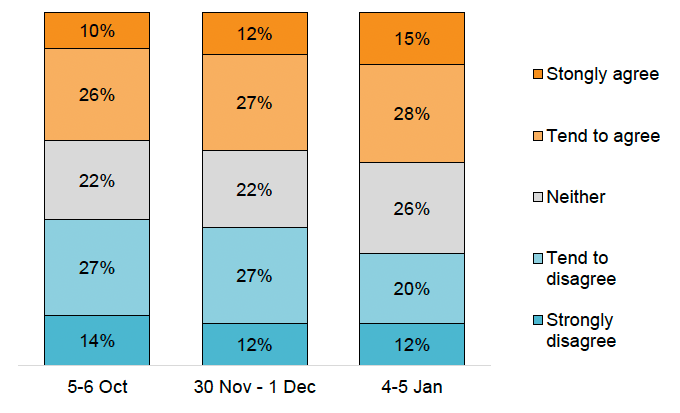
Source: YouGov Scotland Survey. Base: Adults (n=1001-1044)
Contact
Email: covid-19.behaviours@gov.scot
There is a problem
Thanks for your feedback